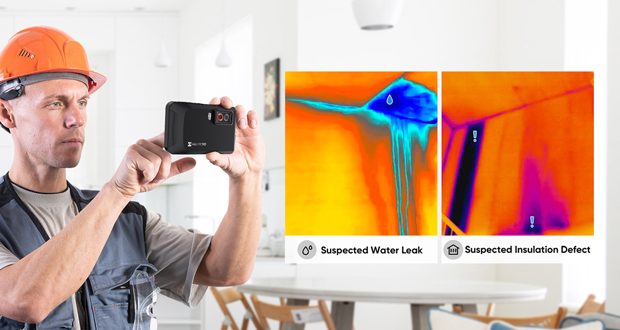 Andrew Green, Thermography Business Development Manager for HIKMICRO explains how the use of smarter and faster AI-powered thermal imaging solutions helps identify water leaks
Andrew Green, Thermography Business Development Manager for HIKMICRO explains how the use of smarter and faster AI-powered thermal imaging solutions helps identify water leaks
Finding leaks, water ingress and faults is central to property management and maintenance as if spotted early it can save time, money and hassle. FMs are increasingly turning to sophisticated measurement and detection equipment to enhance the precision and efficiency of their work. Among these, light and easy-to-use handheld thermal imaging cameras have emerged as indispensable assets. These devices streamline diagnostic processes, significantly reducing the time spent on site, and can be used for surveying areas that are hard to reach with more limited, conventional tools.
HEAT SEEKING TECH
The wider application of this technology allows users to clearly see heat patterns in various systems, helping them identify problems that are not visible to the naked eye. Consequently, they’re ideal for electrical or property inspections, energy efficiency audits, safety checks and HVAC works, plus more sensitive environments like factories and airports where maintenance needs to be scheduled around busy periods.
Real-time diagnostic capability also allows for the early detection of overheating, which is often a precursor to equipment failure. By pinpointing hot spots and other irregular thermal patterns, FMs can identify components that are at risk of breaking down, schedule maintenance proactively and replace parts before they cause system-wide issues. This predictive maintenance approach minimises downtime, enhances safety by reducing the risk of fires and other hazards, and optimises operational efficiency.
WATER LEAKS
Thermal imaging also plays a major role in identifying water leaks, that help minimise disruption, reduce the need for full scale repairs and help prevent water damage before it becomes a bigger problem. It works by detecting temperature differences on surfaces, allowing users to quickly identify areas affected by moisture or water ingress. Image enhancement technology significantly improves image clarity and helps visualise leaks hidden behind walls or under floors, while the temperature contrast functionality enables FMs to quickly narrow down the problem without invasive procedures.
But imagine being able to work even faster and more efficiently – with ultra smart detection built in as standard and specialised inspection tools that can provide a more accessible, affordable and intuitive solution for everyday challenges. The development of highly intelligent algorithmic functions is reshaping the safe, automated and accurate inspection experience across both commercial and industrial applications – turning advanced diagnostics into actionable insights for first time users and seasoned FM professionals alike.
AI-DRIVEN INNOVATIONS
An AI-driven innovation now automatically identifies problematic water leaks by analysing sound frequency, intensity, and spatial characteristics to pinpoint the exact leak point. Traditional acoustic leak detectors require trained professionals to interpret audio feedback and distinguish between normal pipe noises and potential leaks; however, this algorithm automatically isolates the relevant noise patterns, making the detection process fast and straightforward and allowing even first-time users to achieve professional-level results with minimal training.
When it comes to identifying air leaks, heat loss and moisture damage there is also a bespoke deep learning algorithm designed to simplify the inspection process and make it faster. It focuses on a vast collection of thermal images representing typical issues such as insufficient insulation and water leakage. This enables the software to quickly and accurately identify potential insulation deficiencies and suspicious water leaks during Infrared (IR) inspections, which immediately makes it the essential smart scene recognition assistant for newcomers to thermal imaging equipment.
For more experienced, professional users there is enhanced functionality, whereby an intuitive colour algorithm works with additional tools like hygrometers to analyse and alarm thermal images based on temperature and humidity data. During IR inspections, this helps quickly pinpoint potential insulation defects (marked with a blue alarm) and suspicious moisture issues (marked with a green alarm) – to tangibly boost efficiency, accuracy and clarity of image.
Automated risk detection for electrical panel inspection and PCB safety is now a reality, simplifying workflows via built-in algorithms that identify temperature measurement targets in specific scenarios and determine if anomalies exist. This reduces the complexity of FM operations to improve inspection safety while reducing downtime risks and optimising equipment lifecycle management efficiency.
In electrical panel inspection, image recognition and Delta T (ΔT) algorithms are combined to accurately locate overloaded/degraded fuses through absolute temperature alarms and relative difference warnings. Micro-temperature sensing can also detect thermal differences as low as 0.5°C, flagging potential hazards before they escalate.
These latest innovations represent a giant leap forward in making thermal imaging even more intuitive, intelligent and inclusive – bringing absolute precision and consistency to tasks that once demanded extensive time and expertise. Whether you’re inspecting a property, tracking down a water leak or safeguarding an industrial system, breakthrough AI-driven functionality now makes every inspection smarter, every decision faster and every outcome more reliable.





